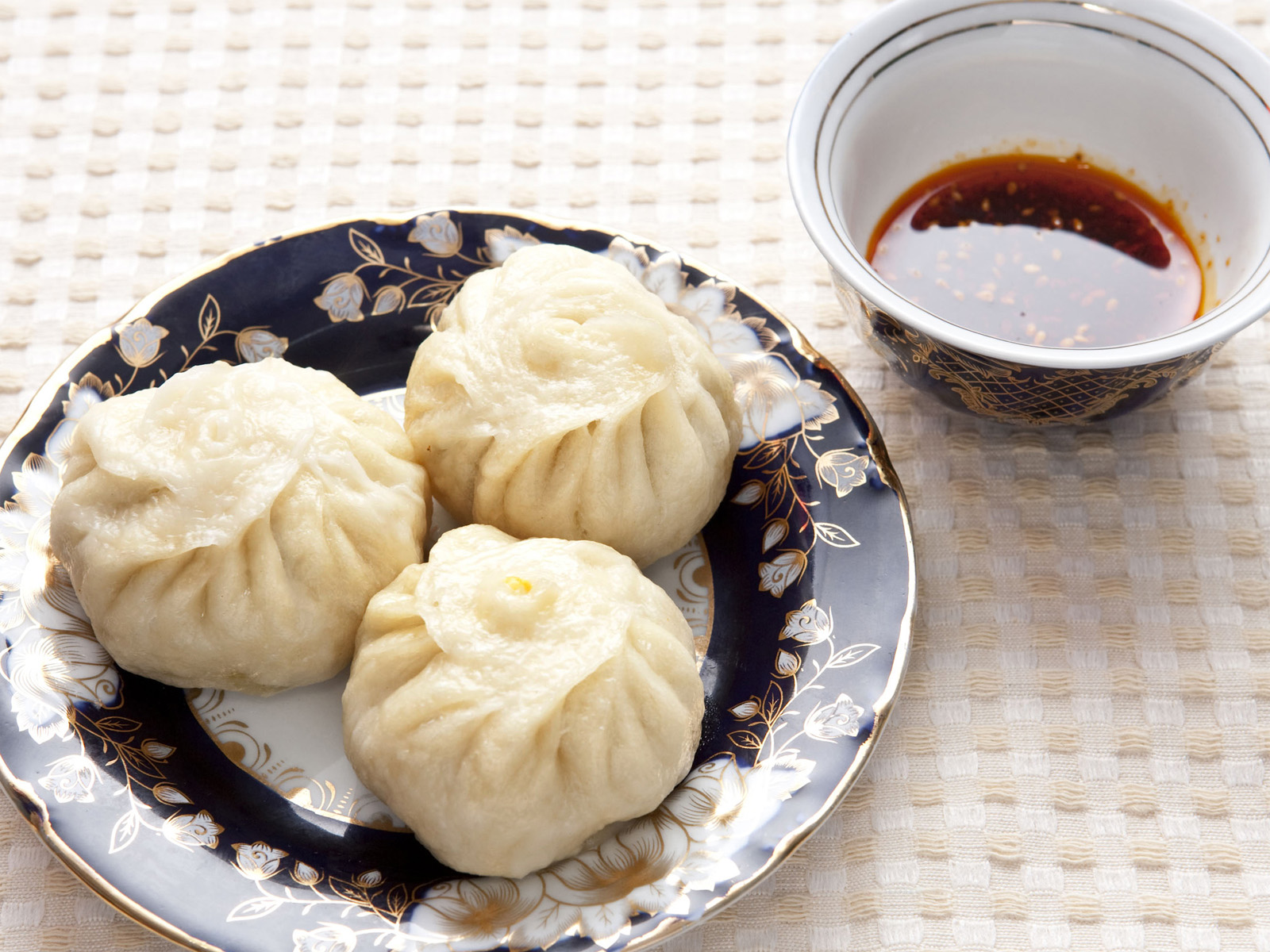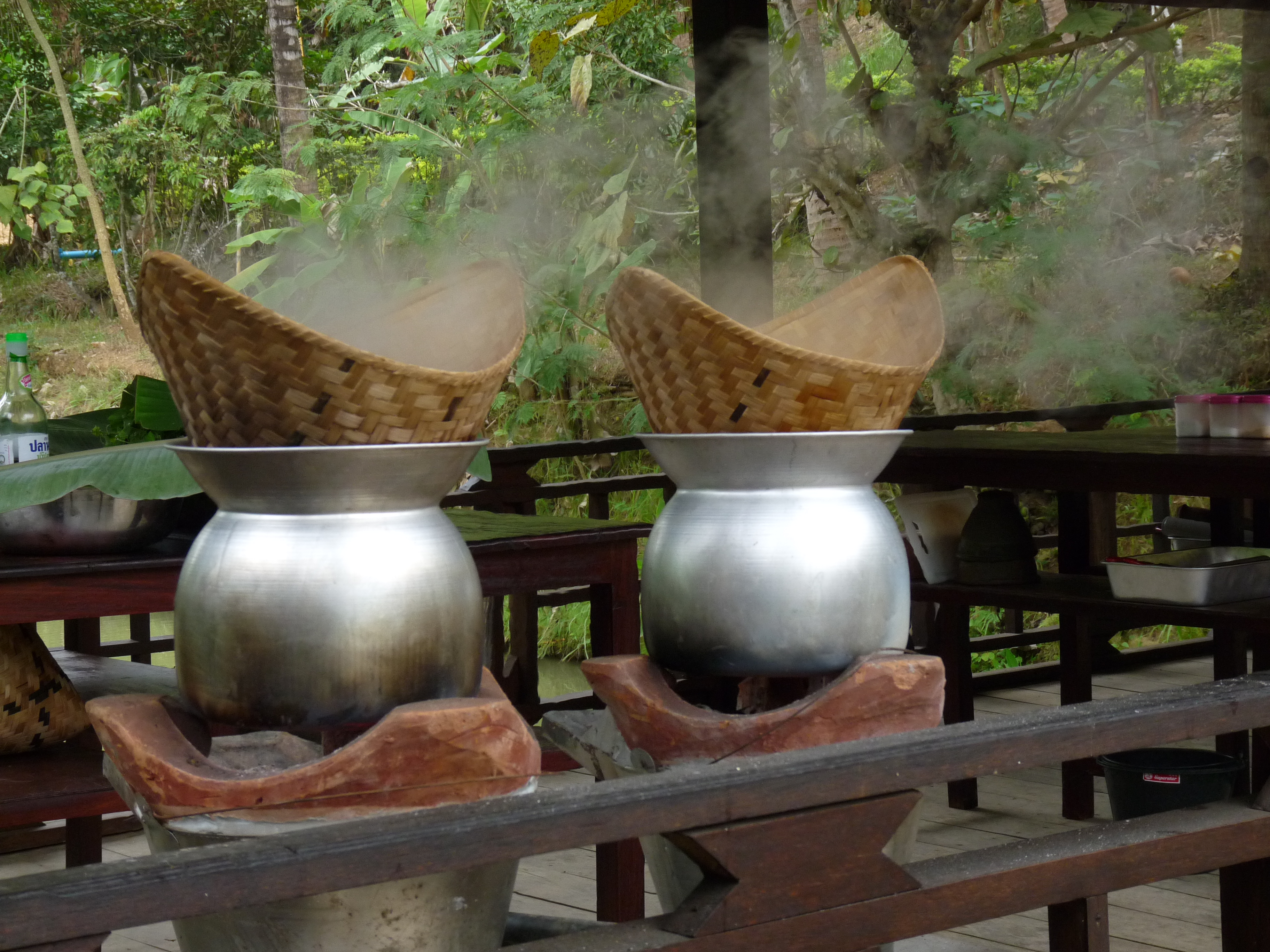|
Dumplings
Dumplings are a broad class of dishes that consist of pieces of cooked dough (made from a variety of starchy sources), often wrapped around a filling. The dough can be based on bread, wheat or other flours, or potatoes, and it may be filled with meat, Fish as food, fish, tofu, cheese, vegetables, or a combination. Dumplings may be prepared using a variety of cooking methods and are found in many world cuisines. One of the earliest mentions of dumplings comes from the Chinese scholar Shu Xi who mentions them in a poem 1,700 years ago. In addition, archaeologically preserved dumplings have been found in Turpan, Turfan, Xinjiang, China dating back over 1,000 years. Definition The precise definition of a dumpling is controversial, varying across individuals and cultures. The term emerged in English by the 17th century, where it referred to a small lump of dough cooked by simmering or steaming. The definition has since grown to include filled dumplings, where the dough encloses ... [...More Info...] [...Related Items...] OR: [Wikipedia] [Google] [Baidu] |
Pierogi
Pierogi ( ; ) are filled dumplings made by wrapping Leavening, unleavened dough around a Stuffing, filling and cooked in boiling water. They are occasionally flavored with a savory or sweet garnish. Typical fillings include potato, cheese, Quark (dairy product), quark, sauerkraut, ground meat, Edible mushroom, mushrooms, fruits, or Berry, berries. Savory pierogi are often served with a topping of sour cream, fried onions, or both. Pierogi varieties are associated with the cuisines of Central European cuisine, Central, Eastern European cuisine, Eastern and Southeast Europe, Southeastern Europe. Dumplings most likely originated in Asia and came to Europe via trade in the Middle Ages. However, the dish itself dates back to at least 1682, when Poland's first cookbook, ''Compendium ferculorum, albo Zebranie potraw'', was published. The widely used English name pierogi was derived from Polish language, Polish. In Ukraine and parts of Canadian cuisine, Canada they are known under t ... [...More Info...] [...Related Items...] OR: [Wikipedia] [Google] [Baidu] |
Khinkali
Khinkali () is a dumpling in Georgian cuisine. It is made of twisted knobs of dough, stuffed with meat or vegetables and spices. The concept of dumplings is said to have been carried west from China, across Mongolia, Russia and Georgia, by the Mongols in the 13th century. Ingredients The fillings of khinkali vary with the area. The original recipe, the so-called ''khevsuruli'', consisted of only minced meat (lamb, beef or pork mixed), onions, chili pepper, salt, and cumin. However, the modern recipe used mostly especially in Georgian urban areas, the so-called ''kalakuri'', uses herbs like parsley and coriander. Mushrooms, potatoes, or cheese may be used in place of meat. Beef or lamb is usual in halal and kosher, which never include pork for religious reasons. Etiquette Khinkali is eaten plain or with ground black pepper. The meat filling is uncooked when khinkali is assembled, so when it is cooked, the juices of the meat are trapped inside the dumpling. To make khinkali ... [...More Info...] [...Related Items...] OR: [Wikipedia] [Google] [Baidu] |
Kenkey
Kenkey (also known as kɔmi, otim, kooboo or dorkunu) is a staple swallow food similar to sourdough dumplings from the Ga and Fante-inhabited regions of West Africa, usually served with pepper crudaiola and fried fish, soup or stew. Description Kenkey is produced by steeping grains of maize in water for about one week, before they are then milled and kneaded with water into a dough. The dough is allowed to ferment for four days to a week before part of the dough is cooked. Variations Areas where kenkey is eaten include Ghana, eastern Côte d'Ivoire, Togo and western Benin. It is usually made from ground corn (maize), like sadza and ugali. It is popularly known as kɔmi (pronounced kormi) by the Gas or dokono by the Akans in Ghana. In the Caribbean, there are variations of an indigenous dessert of Mesoamerican origin, i.e. sweet tamale, which was adopted by Africans brought to the region during slavery and indentureship. As such, African influence can be found i ... [...More Info...] [...Related Items...] OR: [Wikipedia] [Google] [Baidu] |
Manti (food)
Manti is a type of dumpling mainly found in Turkish cuisine, Armenian cuisine and Central Asian cuisine but also in West Asia, South Caucasus, and the Balkans. Manti is also popular among Chinese Muslims, and it is consumed throughout post-Soviet countries, where the dish spread from the Central Asian republics.More Than Just Another Dumpling , The School of Russian and Asian Studies, retrieved 25 January 2014 The dumplings typically consist of a spiced meat mixture, usually lamb or , wrapped in a thin dough sheet which is then boiled or steamed. The size and shape of manti vary significantly depending on geographi ... [...More Info...] [...Related Items...] OR: [Wikipedia] [Google] [Baidu] |
Wonton
A wonton ( zh, t=, s=馄饨, p=húntun, j=wan4 tan4, first=t) is a type of Chinese dumpling commonly found across regional styles of Chinese cuisine. It is also spelled wantan or wuntun, a transliteration from Cantonese zh, j=wan4 tan1, labels=no (), and wenden from Shanghainese (). Even though there are many different styles of wonton served throughout China, Cantonese wontons are the most popular in the West due to the predominance of Cantonese restaurants overseas. Wontons, which have their origins in China, have achieved significant popularity as a sought-after delicacy that is not only celebrated and enjoyed in East Asian cuisine, but also across various Southeast Asian culinary traditions. Names In Mandarin, they are called ''huntun'' ( zh, s=馄饨, t=餛飩, p=húntun, first=s). In Cantonese, they are called ''wantan'' ( zh, s=云吞, t=雲吞, j=wan4 tan1, cy=wàhn tān, first=s), which means "cloud swallow" because when they are cooked, the dumplings float ... [...More Info...] [...Related Items...] OR: [Wikipedia] [Google] [Baidu] |
Kozhukkatta
Kozhukatta (), kozhukkattai ( or kudumu ( Telugu: కుడుము), Modaka (), Modak () is a popular South Indian dumpling made from rice flour, with a filling of grated coconut, jaggery, or chakkavaratti. Kozhukatta, although usually sweet, can sometimes be stuffed with a savory filling. '' Modak'' is a similar dish made in other parts of India. Preparation The dish is prepared by mixing grated coconut with jaggery syrup, placing it inside dumplings of rice flour, and steaming the dumplings. Ghee, cardamom, finely ground roasted rice flour etc. may be added to enhance the taste and flavor of the filling. In Kerala, a variant of kozhukatta made with atta flour (instead of rice flour) and grated coconut is a staple breakfast among some groups. Culture In Tamil Nadu, the dish is traditionally associated with the Hindu God Ganesha and is prepared as an offering ('' naivedhya'') on the occasion of Vinayaka Chathurthi. In Kerala, it is popularly associated with Oshana Sunday c ... [...More Info...] [...Related Items...] OR: [Wikipedia] [Google] [Baidu] |
Simmering
Simmering is a food preparation technique by which foods are cooked in hot liquids kept just below the boiling point of water (lower than ) and above poaching temperature (higher than ). To create a steady simmer, a liquid is brought to a boil, then its heat source is reduced to a lower, constant intensity (smaller flame on a gas stove, lower temperature on an induction/electric stove). Visually a liquid will show a little movement without approaching a rolling boil. Methods and equipments Simmering ensures gentler treatment than boiling to prevent food from toughening and/or breaking up. Simmering is usually a rapid and efficient method of cooking. Food that has simmered in milk or cream instead of water is sometimes referred to as creamed. The appropriate simmering temperature is a topic of debate among chefs, with some but not all considering that a simmer is as low as . Some modern gas ranges have a simmering burner, which may be a rear burner, supporting a steady low hea ... [...More Info...] [...Related Items...] OR: [Wikipedia] [Google] [Baidu] |
China
China, officially the People's Republic of China (PRC), is a country in East Asia. With population of China, a population exceeding 1.4 billion, it is the list of countries by population (United Nations), second-most populous country after India, representing 17.4% of the world population. China spans the equivalent of five time zones and Borders of China, borders fourteen countries by land across an area of nearly , making it the list of countries and dependencies by area, third-largest country by land area. The country is divided into 33 Province-level divisions of China, province-level divisions: 22 provinces of China, provinces, 5 autonomous regions of China, autonomous regions, 4 direct-administered municipalities of China, municipalities, and 2 semi-autonomous special administrative regions. Beijing is the country's capital, while Shanghai is List of cities in China by population, its most populous city by urban area and largest financial center. Considered one of six ... [...More Info...] [...Related Items...] OR: [Wikipedia] [Google] [Baidu] |
Boiling
Boiling or ebullition is the rapid phase transition from liquid to gas or vapor, vapour; the reverse of boiling is condensation. Boiling occurs when a liquid is heated to its boiling point, so that the vapour pressure of the liquid is equal to the pressure exerted on the liquid by the Standard atmosphere (unit), surrounding atmosphere. Boiling and evaporation are the two main forms of liquid vapourization. There are two main types of boiling: nucleate boiling, where small bubbles of vapour form at discrete points; and critical heat flux boiling, where the boiling surface is heated above a certain critical temperature and a film of vapour forms on the surface. Transition boiling is an intermediate, unstable form of boiling with elements of both types. The boiling point of water is 100 °C or 212 °F but is lower with the decreased atmospheric pressure found at higher altitudes. Boiling water is used as a method of making it potable by killing Microorganism, microbes an ... [...More Info...] [...Related Items...] OR: [Wikipedia] [Google] [Baidu] |
Frying
Frying is the cooking of food in cooking oil, oil or another fat. Similar to sautéing, pan-fried foods are generally turned over once or twice during cooking to make sure that the food is evenly cooked, using tongs or a spatula, whilst sautéed foods are cooked by "tossing in the pan". A large variety of foods may be fried. History Frying is believed to have first appeared in the Ancient Egyptian Ancient Egyptian cuisine, kitchen, during the Old Kingdom of Egypt, Old Kingdom, around 2500 BC.Tannahill, Reay. (1995). ''Food in History''. Three Rivers Press. p. 75 Around the Middle Ages, fried food became a common delicacy for wealthy people, with fried meats and vegetables becoming popular dishes. It is believed that frying was created, and used, as a way to preserve food. Variations Unlike water, fats can reach temperatures much higher than 100 °C (212 °F) before boiling. This paired with their heat absorption properties, neutral or desired taste, and non-tox ... [...More Info...] [...Related Items...] OR: [Wikipedia] [Google] [Baidu] |
Steaming
Steaming is a method of cooking using steam. This is often done with a food steamer, a kitchen appliance made specifically to cook food with steam, but food can also be steamed in a wok. In the American Southwest, steam pits used for cooking have been found dating back about 5,000 years. Steaming is considered a healthy cooking technique that can be used for many kinds of foods. Compared to full immersion in boiling water, steaming can be faster and more energy-efficient because it requires less water and takes advantage of the excellent thermodynamic heat transfer properties of steam. History Some of the world's earliest examples of steam cooking were found in China's Yellow River Valley; early steam cookers made of stoneware have been found dating back as far as 5,000 BCE. And also in Gunma Prefecture, Japan, created during the Stone Age. Some of the earliest examples of steam cooking have been found in Italy and Sardinia, created during the Bronze Age, and in Cochise Cou ... [...More Info...] [...Related Items...] OR: [Wikipedia] [Google] [Baidu] |








